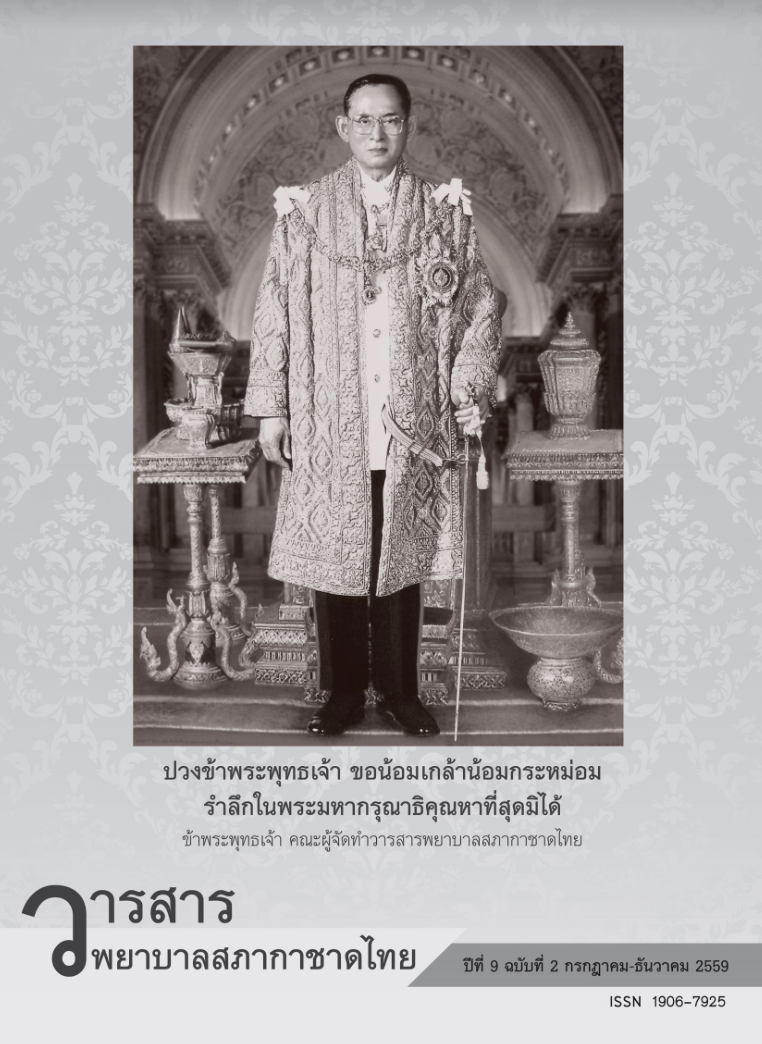สถานการณ์และปัจจัยที่มีความสัมพันธ์กับการตกเลือดหลังคลอดในมารดาคลอดทางช่องคลอด ในหอผู้ป่วยสูติกรรมสามัญ โรงพยาบาลนพรัตนราชธานี
Keywords:
การตกเลือดหลังคลอด, การคลอดทางช่องคลอด, รกค้าง, postpartum hemorrhage, vaginal delivery, retained of placentaAbstract
การวิจัยเชิงบรรยายแบบหาความสัมพันธ์นี้เพื่อวิเคราะห์สถานการณ์และปัจจัยที่มีความสัมพันธ์กับการตกเลือดหลังคลอด กรอบแนวคิดในการวิจัยครั้งนี้ใช้ The Nursing Role Effectiveness model โดย Irvine และคณะ กลุ่มตัวอย่างเลือกแบบเฉพาะเจาะจง ประกอบด้วยพยาบาลวิชาชีพ จำนวน 13 คน และเวชระเบียนมารดาหลังคลอด จำนวน 104 ราย เก็บรวบรวมข้อมูลโดยใช้แบบสอบถามข้อมูลของพยาบาล และแบบบันทึกข้อมูลจากเวชระเบียนมารดาหลังคลอด วิเคราะห์ข้อมูลโดยใช้สถิติเชิงพรรณนา Chi square และ Fisher’s Exact Test
ผลการวิจัย ด้านโครงสร้าง พบว่า พยาบาลส่วนใหญ่มีประสบการณ์ทำงานในหอผู้ป่วยสูติกรรมสามัญมากกว่า 15 ปี ได้รับการอบรมเพื่อพัฒนาสมรรถนะทางการพยาบาลทุกปี พยาบาลใหม่ได้รับการเตรียมความพร้อมด้วยระบบพยาบาลพี่เลี้ยงนาน 6 เดือน ด้านมารดาหลังคลอด พบว่ามีอายุเฉลี่ย 26.54 ปี ส่วนใหญ่ไม่มีภาวะโลหิตจางและไม่มีประวัติการขูดมดลูก ด้านกระบวนการ พบว่า พยาบาลมีการใช้แนวปฏิบัติในการป้องกันและดูแลรักษาภาวะตกเลือดหลังคลอดของทีมสูตินรีเวชกรรมของโรงพยาบาล และแนวปฏิบัติการจัดการในระยะที่สามของการคลอดโดยเร็วตามแนวทางของ WHO ด้านผลลัพธ์ พบว่า อุบัติการณ์ตกเลือดหลังคลอดในหอผู้ป่วยสูติกรรมสามัญมี 26 ราย (ร้อยละ 0.64) สาเหตุหลัก คือ รกหรือเศษรกค้าง ปัจจัยที่มีความสัมพันธ์กับการตกเลือดหลังคลอดอย่างมีนัยสำคัญทางสถิติที่ p < .05 ได้แก่ การศึกษา ระยะเวลาที่ใช้ในการคลอดระยะที่ 3 วิธีการคลอดรก ความสมบูรณ์ของรก ความผิดปกติของรก และการใช้ยากระตุ้นมดลูกในระยะคลอด
Situation and Factors Associated with Maternal Postpartum Hemorrhage with Vaginal Delivery in the Obstetric Ward, Nopparatrajathanee Hospital
This descriptive study aimed to investigate the situation and factors related to postpartum hemorrhage. Irvine’s Nursing Role Effectiveness model was used as a conceptual framework. Thirteen nurses and one hundred and four medical records of mothers with vaginal delivery were purposively selected. Questionnaires were used to collect the demographic data of the nurses and data collection forms were used to gather the demographic and obstetric data of the mothers from their medical records. Descriptive statistics, Chi-square and Fisher’s exact test were used in analyzing the data.
The findings revealed that majority of the nurses have been working on the maternity ward for more than 15 years and have been trained, annually, to develop their nursing competencies. A preceptorship program (6 months) was used to prepare the new nurses who started working on the ward. The average age of maternal postpartum was found to be 26.54 years old, without anemia, nor any history of uterine curettage/surgical procedure. For the process, the practice guidelines for the prevention and treatment of postpartum hemorrhage was followed by the obstetrics team working on the ward. For the outcome, the incidence of new postpartum hemorrhage on the obstetrics ward occurred in 26 cases of vaginal delivery (0.64%); the most common cause of postpartum hemorrhage was a retained placenta. Factors having a statistically significant (p <.05) association with postpartum hemorrhage were the third stage of labor, types of delivery of the placenta, the integrity of the placenta, abnormalities of the placenta, and the use of uterotonics during labor.
Downloads
Issue
Section
License
เนื้อหาบทความหรือข้อคิดเห็นต่างๆ ในวารสารพยาบาลสภากาชาดไทยนี้ เป็นความคิดเห็นของผู้เขียนบทความ ไม่ใช่ความเห็นของกองบรรณาธิการ หรือสถาบันการพยาบาลศรีสวรินทิรา สภากาชาดไทย






